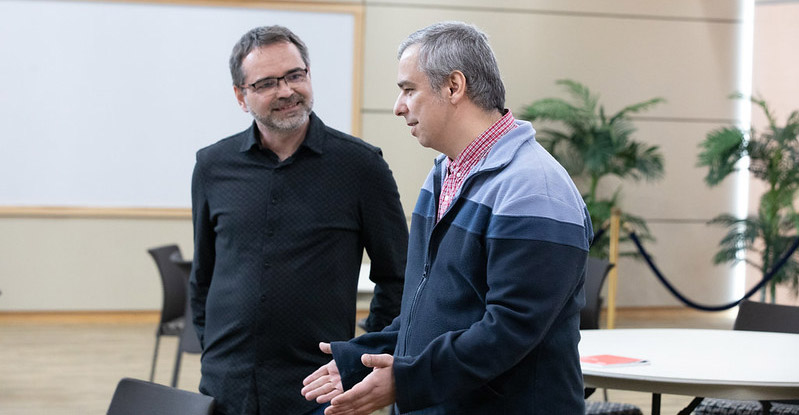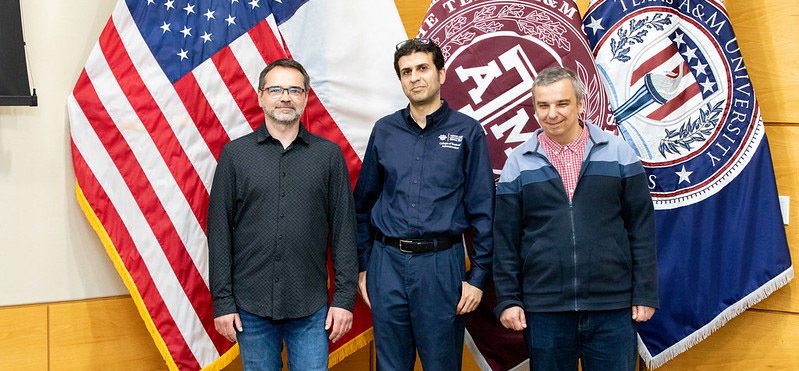
Dariusz Puchala, Ph.D. (left) and Kamil Stokfiszewski, Ph.D., from Lodz, Poland, talk about their research involving data compression and artificial intelligence during a presentation at Texas A&M University–Central Texas recently.
With the proliferation of artificial intelligence shaping the modern marketplace, finding models and uses for the technology has become an increasingly important endeavor for computer scientists. Students, faculty and staff at Texas A&M University–Central Texas were treated to a glimpse into research surrounding the field recently by a pair of visiting professors from Poland.
Dariusz Puchala, Ph.D., and Kamil Stokfiszewski, Ph.D., of Lodz University of Technology in Poland specialize in the field of data compression and are working with A&M–Central Texas Assistant Professor Khaldoon Dhou, Ph.D., to develop advanced models of data compression and determine a means by which artificial intelligence platforms can be compressed for use in smaller devices with less computational power.
Dhou, who teaches in the Subhani Department of Computer Information Systems, invited his colleagues to campus to continue the teams’ research and to introduce the Polish duo to his research methods at a United States university. Stokfiszewski said the “research internship” has been invaluable to their efforts.

Dariusz Puchala, Ph.D., (from left) Khaldoon Dhou, Ph.D., and Kamil Stokfiszewski, Ph.D., are teaming up to work on data compression research. Dr. Dhou is a computer information systems professor at Texas A&M University–Central Texas. Puchala and Stokfiszewski work at the Lodz University of Technology in Poland.
“Since our collaboration becomes intense, Dr. Dhou invited us to see how he works and to work on some things together,” Stokfiszewski said.
As a team, the trio is working on developing compression models through which loss of data during compression goes unnoticed when the files are transferred and re-opened. For instance, a large photo taken in high resolution by a professional camera carries enough data that the file is not easily transferred. When compressed, some of the data is lost to make the file size smaller and more manageable. However, upon decompression, the idea is that the user will notice no difference in the file.
The trio’s work focuses on things much larger than a single photo, however. Stokfiszewski said the loss of data in compression is done, “in a smart way. In such a way that the human is quite satisfied.”
Dhou said the model they developed has significantly out-performed international standards for data compression. Now, the group is continuing its work and focusing on artificial intelligence. Stokfiszewski said they are looking at the neural networks that drive artificial intelligence and trying to find a way to compress the AI models to work properly with far less computational demand.
“Those neural network models are quite huge,” he said. “It takes quite an amount of RAM memory in our computers and mobile devices.”
The group is focusing on compressing AI models so they can be loaded on mobile devices and still function properly. Puchala compared it to a self-contained black box – a complicated device that produces useful information without revealing information about its internal workings. These devices can be used in various industries to transform specific data sets into useful outcomes.
“It works more like the black box,” Puchala said. “We construct the black box. We have data and the black box learns something that allows it to generate results.”
Dhou said not only is having Puchala and Stokfiszewski on campus beneficial to his research, but seeing his own research through their perspective is helping to shape his approach and how he teaches his students.
“That is helping me to shape my lectures,” Dhou said. “When I teach students some concepts in programming and AI, I tell them about what’s happening in the real world and that is giving them additional knowledge, not just what they take from the textbook.”
Dhou said he tries to consistently add content to his lectures that students are unable to find with a simple online search.
“My rule is to add something to my lectures and make them try to connect the dots and connect themselves to their world.”
